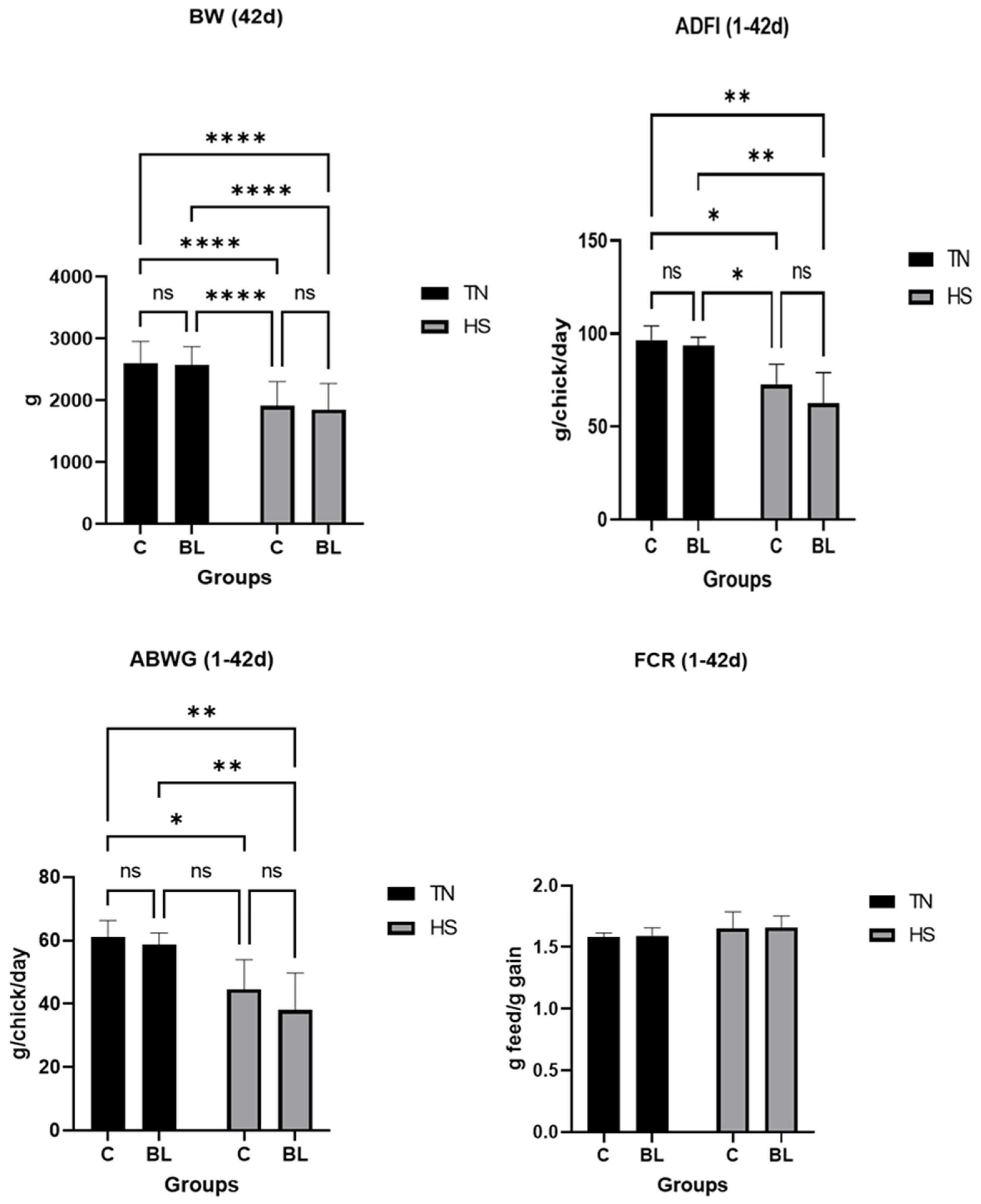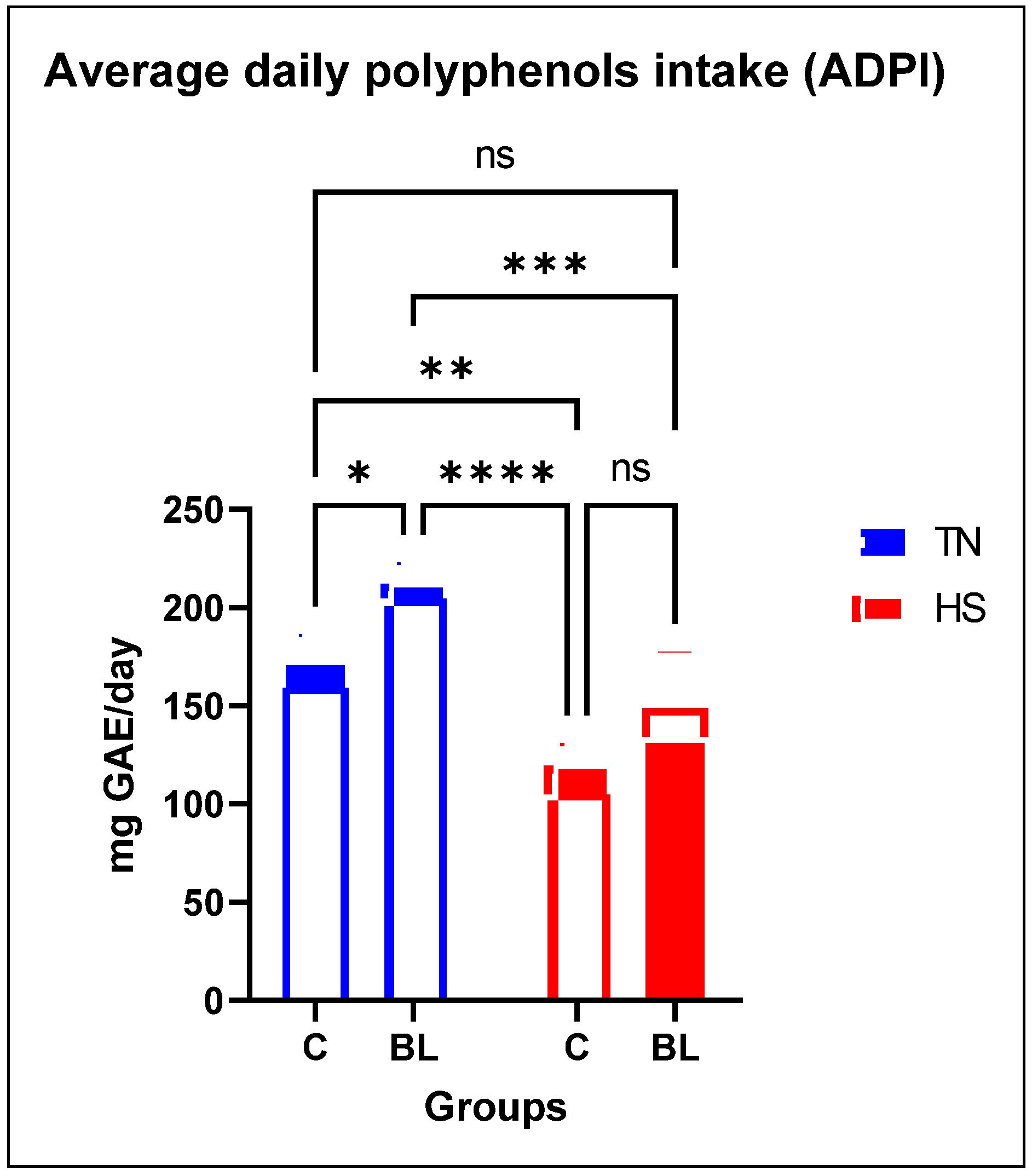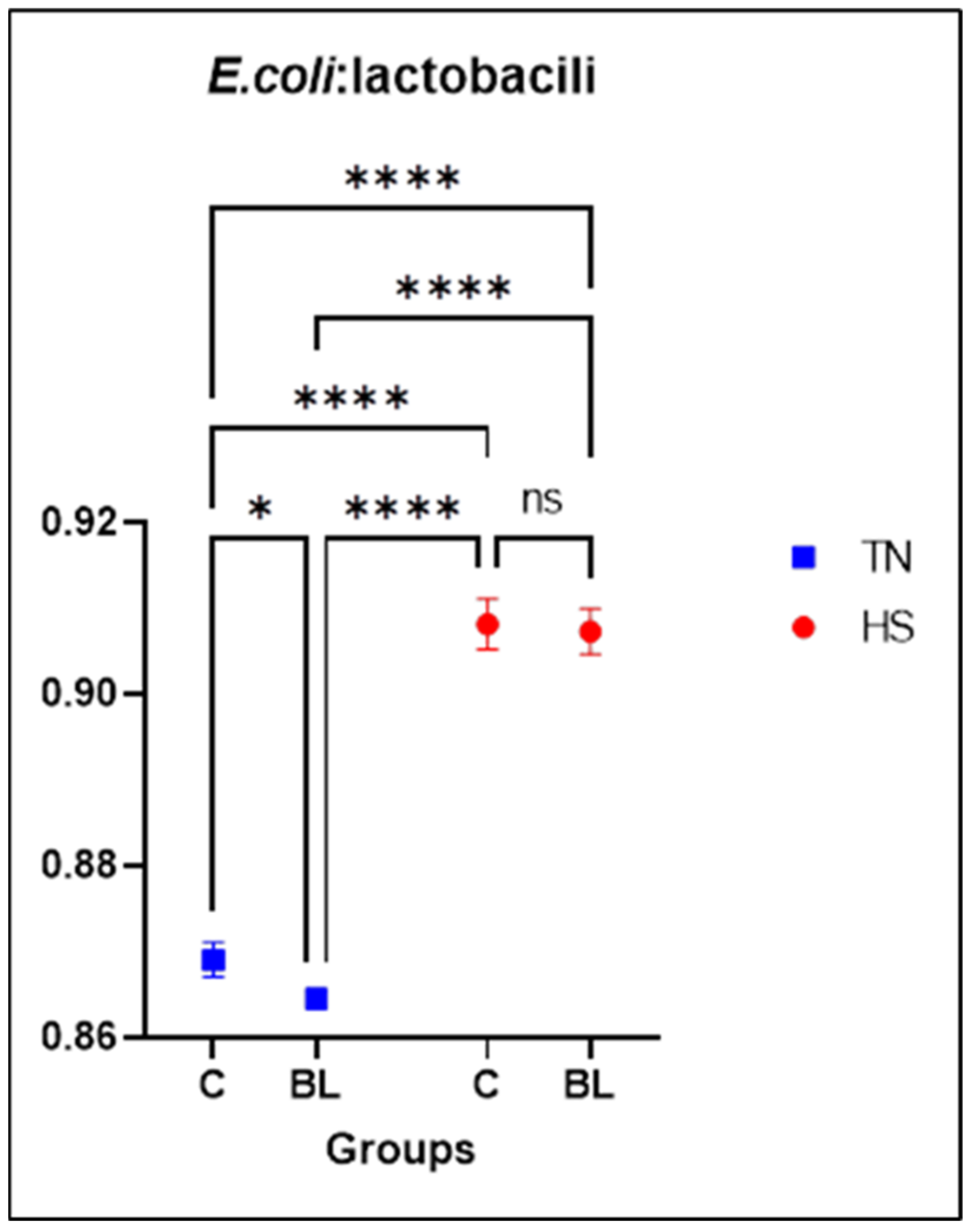Comparative Effects on Using Bilberry Leaves in Broiler Diet Reared under Thermoneutral Conditions vs. Heat Stress on Performance, Health Status and Gut Microbiota
Abstract
:1. Introduction
2. Materials and Methods
2.1. Experimental Design
2.2. Performance Parameters
2.3. Chemical Analysis of Bilberry Leaves
2.3.1. Proximate Analysis of Bilberry Leaves and Feed Samples
2.3.2. Preparation of Methanolic Extract of BL
2.3.3. Quantification of Total Phenolics
2.3.4. Determination of Total Flavonoids
2.3.5. Lutein and Zeaxanthin
2.3.6. Vitamin E
2.3.7. Mineral Micronutrients
2.3.8. Determination of Antioxidant Activity
DPPH Free Radical Scavenging Assay
ABTS Free Radical Scavenging Assay
Phosphomolibdenum Method
Iron (Fe2+) Chelating Activity
2.4. Sample Collection
2.5. Serum Biochemical Attributes
2.6. Intestinal Microflora Analysis
2.7. Statistical Analysis
3. Results and Discussion
3.1. Chemical Composition of Bilberry Leaves
3.2. Serum Metabolites
3.3. Performance
3.4. Intestinal Bacterial Populations
4. Conclusions
Author Contributions
Funding
Institutional Review Board Statement
Informed Consent Statement
Data Availability Statement
Conflicts of Interest
References
- Hirakawa, R.; Nurjanah, S.; Furukawa, K.; Murai, A.; Kikusato, M.; Nochi, T.; Toyomizu, M. Heat stress causes immune abnormalities via massive damage to effect proliferation and differentiation of lymphocytes in broiler chickens. Front. Vet. Sci. 2020, 7, 46. [Google Scholar] [CrossRef] [PubMed]
- Lian, P.; Braber, S.; Garssen, J.; Wichers, H.J.; Folkerts, G.; Fink-Gremmels, J.; Varasteh, S. Beyond heat stress: Intestinal integrity disruption and mechanism-based intervention strategies. Nutrients 2020, 12, 734. [Google Scholar] [CrossRef] [PubMed]
- Mazzoni, M.; Zampiga, M.; Clavenzani, P.; Lattanzio, G.; Tagliavia, C.; Sirri, F. Effect of chronic heat stress on gastrointestinal histology and expression of feed intake-regulatory hormones in broiler chickens. Animal 2022, 16, 100600. [Google Scholar] [CrossRef] [PubMed]
- Ștefănescu, B.-E.; Călinoiu, L.F.; Ranga, F.; Fetea, F.; Mocan, A.; Vodnar, D.C.; Crișan, G. Chemical Composition and Biological Activities of the Nord-West Romanian Wild Bilberry (Vaccinium myrtillus L.) and Lingonberry (Vaccinium vitis-idaea L.) Leaves. Antioxidants 2020, 9, 495. [Google Scholar] [CrossRef] [PubMed]
- Stanoeva, J.P.; Stefova, M.; Andonovska, K.B.; Vankov, A.; Stafilov, T. Phenolics and mineral content in bilberry and bog bilberry from Macedonia. Int. J. Food Prop. 2017, 20, S863–S883. [Google Scholar] [CrossRef]
- Varzaru, I.; Untea, A.E.; Saracila, M. In vitro antioxidant properties of berry leaves and their inhibitory effect on lipid peroxidation of thigh meat from broiler chickens. Eur. J. Lipid Sci. Technol. 2020, 122, 1900384. [Google Scholar] [CrossRef]
- Ghabru, A.; Chauhan, S.; Varshneya, C. Effect of sea buckthorn leaves on antioxidant and microsomal enzymes in poultry birds. J. Phytopharm. 2018, 7, 440–445. [Google Scholar] [CrossRef]
- Kalia, S.; Bharti, V.K.; Giri, A.; Kumar, B.; Arora, A.; Balaje, S.S. Hippophae rhamnoides as novel phytogenic feed additive for broiler chickens at high altitude cold desert. Sci. Rep. 2018, 8, 5954. [Google Scholar] [CrossRef]
- Popescu, R.G.; Voicu, S.N.; Pircalabioru, G.G.; Ciceu, A.; Gharbia, S.; Hermenean, A.; Georgescu, S.E.; Panaite, T.D.; Dinischiotu, A. Effects of dietary inclusion of bilberry and walnut leaves powder on the digestive performances and health of TETRA SL laying hens. Animals 2020, 10, 823. [Google Scholar] [CrossRef]
- Qwele, K.; Hugo, A.; Oyedemi, S.O.; Moyo, B.; Masika, P.J.; Muchenje, V. Chemical composition, fatty acid content and antioxidant potential of meat from goats supplemented with Moringa (Moringa oleifera) leaves, sunflower cake and grass hay. Meat Sci. 2013, 93, 455–462. [Google Scholar] [CrossRef]
- Zou, Y.; Lu, Y.; Wei, D. Antioxidant activity of a flavonoid-rich extract of Hypericum perforatum L. in vitro. J. Agric. Food Chem. 2004, 52, 5032–5039. [Google Scholar] [CrossRef] [PubMed]
- Untea, A.E.; Criste, R.C.; Vladescu, L. Development and validation of a microwave digestion–FAAS procedure for Cu, Mn and Zn determination in liver. Rev. Chim. 2012, 63, 341–346. [Google Scholar]
- Prieto, P.; Pineda, M.; Aguilar, M. Spectrophotometric quantitation of antioxidant capacity through the formation of a phosphomolybdenum complex: Specific application to the determination of vitamin E. Anal. Biochem. 1999, 269, 337–341. [Google Scholar] [CrossRef] [PubMed]
- Sabeena Farvin, K.H.; Andersen, L.L.; Nielsen, H.H.; Jacobsen, C.; Jakobsen, G.; Johansson, I.; Jessen, F. Antioxidant activity of Cod (Gadus morhua) protein hydrolysates: In vitro assays and evaluation in 5% fish oil-in-water emulsion. Food Chem. 2014, 149, 326–334. [Google Scholar] [CrossRef] [PubMed]
- Santos, J.S.; Brizola, V.R.A.; Granato, D. High-throughput assay comparison and standardization for metal chelating capacity screening: A proposal and application. Food Chem. 2017, 214, 515–522. [Google Scholar] [CrossRef] [PubMed]
- Dumitru, M.; Hăbeanu, M.; Lefter, N. Effects of direct-feed microbial Bacillus supplementation on piglet’s microbiota. Sci. Bull. Ser. F Biotechnol. 2020, 24, 154–160. [Google Scholar]
- Untea, A.E.; Varzaru, I.; Panaite, T.D.; Gavris, T.; Lupu, A.; Ropota, M. The effects of dietary inclusion of bilberry and walnut leaves in laying hens’ diets on the antioxidant properties of eggs. Animals 2020, 10, 191. [Google Scholar] [CrossRef]
- Tian, Y.; Puganen, A.; Alakomi, H.-L.; Uusitupa, A.; Saarela, M.; Yang, B. Antioxidative and antibacterial activities of aqueous ethanol extracts of berries, leaves, and branches of berry plants. Food Res. Int. 2018, 106, 291–303. [Google Scholar] [CrossRef]
- Martz, F.; Jaakola, L.; Julkunen-Tiitto, R. Phenolic Composition and Antioxidant Capacity of Bilberry (Vaccinium myrtillus) Leaves in Northern Europe Following Foliar Development and along Environmental Gradients. J. Chem. Ecol. 2010, 36, 1017–1028. [Google Scholar] [CrossRef]
- Ciulca, S.; Roma, G.; Alexa, E.; Radulov, I.; Cocan, I.; Madosa, E.; Ciulca, A. variation of polyphenol content and antioxidant activity in some bilberry (Vaccinium myrtillus L.) populations from Romania. Agronomy 2021, 11, 2557. [Google Scholar] [CrossRef]
- Mäkinen, S.; Hellström, J.; Mäki, M.; Korpinen, R.; Mattila, P.H. Bilberry and Sea Buckthorn Leaves and Their Subcritical Water Extracts Prevent Lipid Oxidation in Meat Products. Foods 2020, 9, 265. [Google Scholar] [CrossRef] [PubMed]
- Lumeij, J.T. Avian clinical biochemistry. In Clinical Biochemistry of Domestic Animals; Kaneko, J.J., Harvey, J.W., Bruss, M.L., Eds.; Academic Press: San Diego, CA, USA, 1997; pp. 857–883. [Google Scholar]
- Cignarella, A.; Nastasi, M.; Cavalli, E.; Puglisi, L. Novel lipid-lowering properties of Vaccinium myrtillus L. leaves, a traditional antidiabetic treatment, in several models of rat dyslipidaemia: A comparison with ciprofibrate. Thromb. Res. 1996, 84, 311–322. [Google Scholar] [CrossRef] [PubMed]
- Brader, L.; Overgaard, A.; Christensen, L.P.; Jeppesen, P.B.; Hermansen, K. Polyphenol-rich bilberry ameliorates total cholesterol and LDL-cholesterol when implemented in the diet of Zucker diabetic fatty rats. Rev. Diabet. Stud. 2013, 10, 270–282. [Google Scholar] [CrossRef] [PubMed]
- Petlevski, R.; Hadžija, M.; Slijepčević, M.; Juretić, D. Effect of “antidiabetis” herbal preparation on serum glucose and fructosamine in NOD mice. J. Ethnopharmacol. 2001, 75, 181–184. [Google Scholar] [CrossRef] [PubMed]
- Odo, R.I.; Onoja, S.O.; Osuagwu, C.O. Impact of heat stress on blood and serum biochemistry parameters in rats. Not. Sci. Biol. 2019, 11, 347–350. [Google Scholar] [CrossRef]
- Xue, L.; He, J.; Gao, N.; Lu, X.; Li, M.; Wu, X.; Geng, Y. Probiotics may delay the progression of nonalcoholic fatty liver disease by restoring the gut microbiota structure and improving intestinal endotoxemia. Sci. Rep. 2017, 7, 45176. [Google Scholar] [CrossRef]
- Miao, Q.; Si, X.; Xie, Y.; Chen, L.; Liu, Z.; Liu, L.; Tang, X.; Zhang, H. Effects of acute heat stress at different ambient temperature on hepatic redox status in broilers. Poult. Sci. 2020, 99, 4113–4122. [Google Scholar] [CrossRef]
- Emami, N.K.; Jung, U.; Voy, B.; Dridi, S. Radical response: Effects of heat stress-induced oxidative stress on lipid metabolism in the avian liver. Antioxidants 2020, 10, 35. [Google Scholar] [CrossRef]
- Saracila, M.; Panaite, T.D.; Papuc, P.C.; Predescu, N.; Untea, A. Dietary phytogenic mixture for broilers reared under thermoneutral and heat stress conditions. Arch. Zootech. 2020, 23, 101–116. [Google Scholar]
- Amara, A.A.; Shibl, A. Role of Probiotics in health improvement, infection control and disease treatment and management. Saudi Pharm. J. 2015, 23, 107–114. [Google Scholar] [CrossRef]
- Shandilya, S.; Kumar, S.; Kumar Jha, N.; Kumar Kesari, K.; Ruokolainen, J. Interplay of gut microbiota and oxidative stress: Perspective on neurodegeneration and neuroprotection. J. Adv. Res. 2021, 38, 223–244. [Google Scholar] [CrossRef]
- Lobiuc, A.; Pavăl, N.E.; Mangalagiu, I.I.; Gheorghiță, R.; Teliban, G.C.; Amăriucăi-Mantu, D.; Stoleru, V. Future Antimicrobials: Natural and Functionalized Phenolics. Molecules 2023, 28, 1114. [Google Scholar] [CrossRef] [PubMed]
- Ullah, F.; Ayaz, M.; Sadiq, A.; Ullah, F.; Hussain, I.; Shahid, M.; Yessimbekov, Z.; Adhikari-Devkota, A.; Devkota, H.P. Potential Role of plant extracts and phytochemicals against foodborne pathogens. Appl. Sci. 2020, 10, 4597. [Google Scholar] [CrossRef]
- Saratale, G.D.; Saratale, R.G.; Kim, D.S.; Kim, D.Y.; Shin, H.S. Exploiting fruit waste grape pomace for silver nanoparticles synthesis, assessing their antioxidant, antidiabetic potential and antibacterial activity against human pathogens: A novel approach. Nanomaterials 2020, 10, 1457. [Google Scholar] [CrossRef] [PubMed]
- Suriyaprom, S.; Mosoni, P.; Leroy, S.; Kaewkod, T.; Desvaux, M.; Tragoolpua, Y. Antioxidants of Fruit Extracts as Antimicrobial agents against pathogenic bacteria. Antioxidants 2022, 11, 602. [Google Scholar] [CrossRef]
- Silva, S.; Costa, E.M.; Mendes, M.; Morais, R.M.; Calhau, C.; Pintado, M.M. Antimicrobial, antiadhesive and antibiofilm activity of an ethanolic, anthocyanin-rich blueberry extract purified by solid phase extraction. J. Appl. Microbiol. 2016, 121, 693–703. [Google Scholar] [CrossRef]
- Tian, Y.; Yang, B. Phenolic compounds in Nordic berry species and their application as potential natural food preservatives. Crit. Rev. Food Sci. Nutr. 2023, 63, 345–377. [Google Scholar] [CrossRef]
- Sadowska, B.; Paszkiewicz, M.; Podsedek, A.; Redzynia, M.; Rozalska, B. Vaccinium myrtillus leaves and Frangula alnus bark derived extracts as potential antistaphylococcal agents. Acta Biochim. Pol. 2014, 61, 163–169. [Google Scholar] [CrossRef]




| Ingredient | Grower (14–28 d) | Finisher (28–42 d) | ||
|---|---|---|---|---|
| C | BL | C | BL | |
| Corn | 36.47 | 35.47 | 40.45 | 39.45 |
| Wheat | 20.00 | 20.00 | 20.00 | 20.00 |
| Corn gluten, 65% CP | 4.00 | 4.00 | 6.00 | 6.00 |
| Soybean meal, 46% CP | 30.2 | 30.2 | 23.95 | 23.95 |
| Sunflower oil | 4.31 | 4.31 | 4.72 | 4.72 |
| Bilberry leaves | - | 1.00 | - | 1.00 |
| Monocalcium phosphate | 1.52 | 1.52 | 1.43 | 1.43 |
| Calcium carbonate | 1.38 | 1.38 | 1.31 | 1.31 |
| Salt | 0.38 | 0.38 | 0.33 | 0.33 |
| Methionine | 0.25 | 0.25 | 0.21 | 0.21 |
| Lysine | 0.29 | 0.29 | 0.36 | 0.36 |
| Choline | 0.05 | 0.05 | 0.05 | 0.05 |
| Vitamin-mineral premix | 1.00 | 1.00 | 1.00 | 1.00 |
| TOTAL | 100 | 100 | 100 | 100 |
| Calculated | ||||
| Metabolizable energy, kcal/kg | 3128.99 | 3217.72 | ||
| Crude protein, % | 21.50 | 20.00 | ||
| Ether extractives, % | 6.01 | 6.49 | ||
| Crude fibre, % | 3.57 | 3.36 | ||
| Calcium, % | 0.87 | 0.81 | ||
| Phosphorus, % | 0.70 | 0.65 | ||
| Available phosphorus, % | 0.43 | 0.41 | ||
| Lysine, % | 1.29 | 0.16 | ||
| Methionine, % | 0.61 | 0.32 | ||
| Tryptophan, % | 0.22 | 1.19 | ||
| Parameter | Bilberry Leaves (BL) |
|---|---|
| Proximate composition | |
| DM, % | 91.67 |
| CP, % | 5.91 |
| EE, % | 1.57 |
| CF, % | 32.67 |
| Ash, % | 3.05 |
| Bioactive compounds | |
| TPC, mg GAE/g | 35.90 |
| TFC, mg QE/g | 5.54 |
| Vitamin E, ppm | 111.28 |
| Lutein + zeaxanthin, ppm | 70.59 |
| Minerals | |
| Cu, ppm | 6.27 |
| Fe, ppm | 83.09 |
| Mn, ppm | 2189.50 |
| Zn, ppm | 34.27 |
| Antioxidant activity | |
| DPPH, mM Trolox | 647.88 |
| ABTS, mM Trolox | 1.39 |
| TAC, mM ascorbic acid equivalent | 301.46 |
| TAC, mM vitamin E equivalent | 184.15 |
| Fe chelating power, mg/g equiv. EDTA | 1.39 |
| Specification | C | BL | SEM | p-Value |
|---|---|---|---|---|
| Total polyphenols | ||||
| TPC, mg/g GAE | 1.79 b | 2.27 a | 0.143 | 0.0286 |
| Antioxidant capacity | ||||
| TAC, mM ascorbic acid equivalent | 29.60 b | 31.79 a | 0.759 | 0.0335 |
| TAC, mM vitamin E equivalent | 30.12 b | 33.20 a | 0.820 | 0.0356 |
| TN | HS | p-Values Summary | |||||
|---|---|---|---|---|---|---|---|
| C | BL | C | BL | Diet | Temp. | Diet × Temp. | |
| Energy parameters | |||||||
| Glucose mg/dL | 212.9 | 222.6 | 246.4 | 237.5 | ns | ns | ns |
| Cholesterol mg/dL | 150.7 a | 144.6 c | 171.6 b | 120.0 c | **** | * | *** |
| Renal metabolism | |||||||
| Albumin, g/L | 1.00 b | 1.00 b | 1.41 a | 1.22 ab | ns | *** | ns |
| Creatinine, mg/dL | 0.10 b | 0.13 ab | 0.17 a | 0.16 a | ns | *** | ns |
| Urea, mg/dL | 2.92 b | 3.11 b | 4.39 ab | 6.36 a | * | *** | ns |
| Mineral metabolism | |||||||
| Phosphorus, mg/dL | 4.89 b | 5.34 ab | 6.19 a | 6.23 a | ns | ** | ns |
| Magnesium, mg/dL | 2.45 a | 2.50 a | 1.36 b | 1.28 b | ns | **** | ns |
| Iron, µg/dL | 90.09 b | 100.2 b | 108.2 ab | 133.7 a | * | *** | ns |
| Liver parameters | |||||||
| Total protein, g/dL | 2.47 | 2.69 | 2.49 | 2.77 | ns | ns | ns |
| Total bilirubin, mg/dL | 0.14 ab | 0.11 b | 0.61 a | 0.49 ab | ns | ** | ns |
| ALT, U/L | 7.55 b | 9.73 b | 38.61 a | 32.24 a | ns | **** | ns |
| AST, U/L | 70.86 b | 69.34 b | 494.4 a | 418.9 a | ns | **** | ns |
| Gamma-glutamyltransferase, U/L | 14.87 b | 22.96 b | 31.68 a | 35.88 a | * | **** | ns |
| Variable | TN | HS | p-Values Summary | ||||
|---|---|---|---|---|---|---|---|
| C | BL | C | BL | Diet | Temp. | Diet × Temp. | |
| Enterobacteriaceae | 6.60 b | 6.64 b | 7.41 a | 7.41 a | ns | **** | ns |
| E. coli | 5.64 a | 5.61 a | 6.21 b | 6.20 b | ns | **** | ns |
| Staphyilococi | 5.71 b | 5.60 c | 5.97 a | 5.97 a | **** | **** | **** |
| Lactobacili | 7.15 b | 7.17 c | 6.18 a | 6.19 a | **** | **** | ns |
| Salmonella spp. | absent | absent | absent | absent | NA | NA | NA |
Disclaimer/Publisher’s Note: The statements, opinions and data contained in all publications are solely those of the individual author(s) and contributor(s) and not of MDPI and/or the editor(s). MDPI and/or the editor(s) disclaim responsibility for any injury to people or property resulting from any ideas, methods, instructions or products referred to in the content. |
© 2023 by the authors. Licensee MDPI, Basel, Switzerland. This article is an open access article distributed under the terms and conditions of the Creative Commons Attribution (CC BY) license (https://creativecommons.org/licenses/by/4.0/).
Share and Cite
Saracila, M.; Untea, A.E.; Varzaru, I.; Panaite, T.D.; Vlaicu, P.A. Comparative Effects on Using Bilberry Leaves in Broiler Diet Reared under Thermoneutral Conditions vs. Heat Stress on Performance, Health Status and Gut Microbiota. Life 2024, 14, 39. https://doi.org/10.3390/life14010039
Saracila M, Untea AE, Varzaru I, Panaite TD, Vlaicu PA. Comparative Effects on Using Bilberry Leaves in Broiler Diet Reared under Thermoneutral Conditions vs. Heat Stress on Performance, Health Status and Gut Microbiota. Life. 2024; 14(1):39. https://doi.org/10.3390/life14010039
Chicago/Turabian StyleSaracila, Mihaela, Arabela Elena Untea, Iulia Varzaru, Tatiana Dumitra Panaite, and Petru Alexandru Vlaicu. 2024. "Comparative Effects on Using Bilberry Leaves in Broiler Diet Reared under Thermoneutral Conditions vs. Heat Stress on Performance, Health Status and Gut Microbiota" Life 14, no. 1: 39. https://doi.org/10.3390/life14010039
APA StyleSaracila, M., Untea, A. E., Varzaru, I., Panaite, T. D., & Vlaicu, P. A. (2024). Comparative Effects on Using Bilberry Leaves in Broiler Diet Reared under Thermoneutral Conditions vs. Heat Stress on Performance, Health Status and Gut Microbiota. Life, 14(1), 39. https://doi.org/10.3390/life14010039










